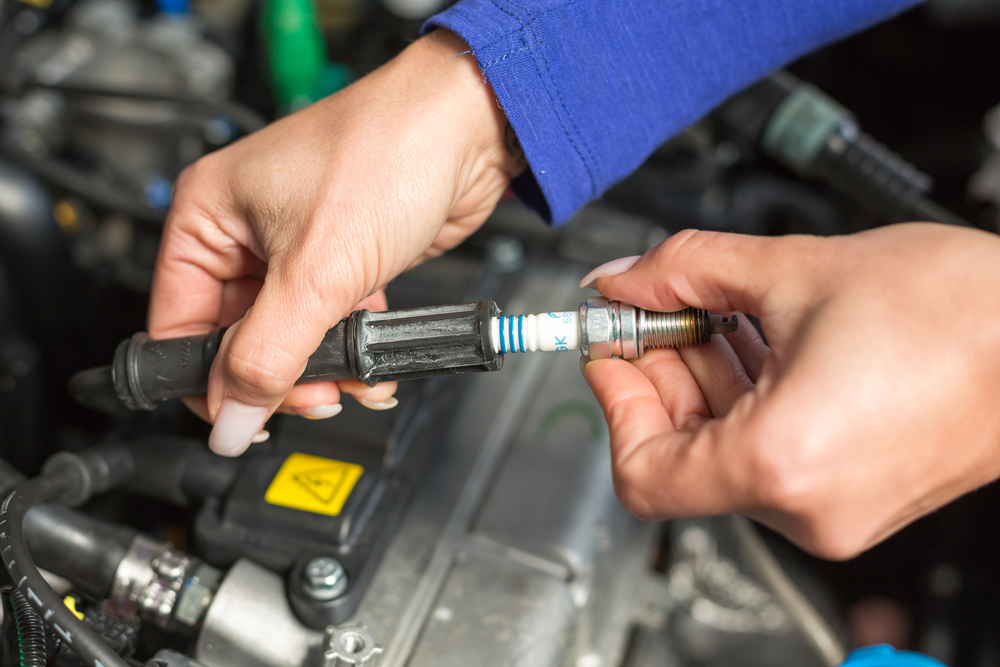If you’ve found oil on a spark plug in your car, that could signal a problem in your engine. However, there’s no need to panic immediately as things may not always be quite as bad as you imagine.
There are quite a few reasons why your spark plug may be oily. In the majority of cases, it will be caused by something relatively simple such as a leaking spark plug O-ring or valve cover. Both of these components are easy to replace. However, in some cases, the cause will be something more serious such as a head gasket leak. This will require more complex repairs.
How Will Oil on a Spark Plug Impact on the Engine?
If the spark plug is oily, it cannot produce a spark. This means ignition cannot take place and, therefore, no combustion in the chamber. Although fuel is delivered to it, it exits the cylinder without being burned.
Also, if the combustion chamber gets filled with traces of oil and those oil particles start to burn with gasoline, this will have a serious impact on the performance of the engine.
Even worse, oil on a spark plug for extended periods of time may cause catastrophic damage to the vehicle’s catalytic converter because of the unburned fuel. Also, the engine bearings could get worn down because of the extra gasoline that ends up inside the oil pan. For this reason, this is a severe condition that requires rectification immediately.
Why Is There Oil on the Spark Plug?

The spark plug is one of just a handful of components that comes into immediate contact with the process of combustion. By contrast, engine oil shouldn’t be there.
So, how can it get onto the spark plug at all? Here are the usual suspects.
The Valve Cover Gasket
The spark plug isn’t the only vehicle component to be installed on the cylinder head. Depending on your engine’s design, there may also be exhaust and intake valves, cams, valve guides and valve springs. Those components usually require lubrication and therefore, engine oil gets pumped to the cylinder heads from the oil pan. The valve cover gasket is designed to keep oil on the cylinder head and away from the remainder of the vehicle’s engine. Because of the very high temperatures in this part of the vehicle, the valve cover gasket is more prone to wear and tear, thus allowing oil to leak. Dripping oil may then reach the spark plugs when the engine has an OHV (Overhead Valve) design, and this results in oil on the spark plug.
The O-Ring
Engines that have a DOHC (Double Overhead Cam) or an SOHC (Single Overhead Cam) design will have a valve cover that includes an O-ring seal. Just like the valve cover gasket as mentioned above, heat has a tendency to degrade the seal over time and this allows the oil to get onto the spark plug.
Worn or Defective Valve Guides
One other reason for the problem could be down to excessive wear and tear on the vehicle’s valve guides. This is because the valves constantly move up and down to pump the oil into the vehicle’s combustion chamber and this can cause oil to get onto the spark plug.
Piston Compression Rings
If the compression ring is broken, this could also cause this problem. If the vehicle’s engine begins to age, its compression can start dropping and this causes positive pressure to build up inside the oil pan. This pressure finds its way during the compression cycle into the vehicle’s combustion chamber should the compression ring break.
Faulty Head-Gasket
Engine oil will flow out of the vehicle’s oil pan to the engine head under pressure via the vehicle’s oil lubrication system. If the head gasket is faulty, this could result in oil entering either the engine cylinder or the vehicle’s cooling system.
Broken Piston Head
Although this isn’t the most likely cause, it is possible that a broken piston head could cause oil on a spark plug. This is because positive pressure that comes from the vehicle’s oil pan may pass freely to the vehicle’s combustion chamber via the piston and, thereby, onto its spark plug.
How Do I Know if There Is Oil on the Spark Plug?
There are several symptoms that could indicate that one or more of your spark plugs has oil on it. Here are a few to look out for:

- Blue smoke comes out of the vehicle’s tailpipe – If your vehicle is suffering from a serious problem due to oil on the spark plug, you will see blue exhaust fumes. You must address this condition rapidly if this occurs.
- Poor fuel economy – This condition increases your vehicle’s fuel consumption significantly.
- Decreased engine performance – Regardless of driving conditions, this condition causes engine performance to decrease because there is reduced efficiency in the combustion chamber.
- Engine misfires – When combustion energy is affected, misfires in the engine can be caused and these may be especially noticeable in certain driving conditions.
- Backfiring – Fuel particles cannot burn in their usual way inside the vehicle’s combustion chamber and so they enter with a higher energy charge into the exhaust pipe. This energy is then released as a mini explosion.
- An unpleasant odor from the vehicle’s exhaust pipe – It’s possible an unpleasant odor of gasoline and oil will be detected coming from your vehicle’s tailpipe. Bad combustion will also add to the smell.
How Can I Work Out Why There Is Oil on the Spark Plug?
You will need to go through a certain diagnostic process in order to determine the cause of oil on your vehicle’s spark plug. Here are a few steps to help guide you through the process.
Inspect the Engine Visually
The first step is to visually examine the engine. The way you do this will depend on the type of engine your vehicle has.
If it has an OHV engine, you will need to visually inspect the exterior of the cylinder heads. If you spot any oil coming out of the valve cover gasket, you should replace it.
If you have a DOHC or SOHC engine, you should carry out the same inspection procedure outlined above, replacing valve cover gaskets when necessary. You should also check out the spark plugs’ exterior condition. If you see traces of engine oil on the coil-over-plug, ceramic coating of the spark plug, or its wires, replace all of the O-ring seals.
Engine Testing
In around 80% of cases, oil on the spark plug will be caused as a result of a damaged O-ring or valve cover gasket. In 20% of cases, though, engine problems are the cause.
If the above visual inspection sheds no light on the cause of oil on the spark plug, try the following steps next.
An Engine Compression Test
First, warm your engine until it has reached the normal temperature for operation. Next, remove all of the spark plugs, then manually turn the vehicle’s crankshaft in its usual rotation directly until the first piston reaches the compression stroke at the TDC (top dead center). Utilizing the correct adapter, you must now connect the first cylinder to the engine compression gauge. Disable both the ignition and fuel system before cranking the engine six revolutions, all the while maintaining the pedal on a wide-open throttle. Note down the reading on the gauge, then repeat the same procedure for every cylinder. Finally, check the manufacturer’s literature to see whether or not those figures are within the appropriate range (typically anything over 100 psi will be fine). If there is a difference between cylinders of more than 10%, this is considered to be suspicious, particularly if one cylinder has oil on the spark plug.
An Engine Differential Pressure Test
Involving a source of compressed, clean air, this isn’t as popular a test as the one outlined above, but it can save you a considerable amount of time when it comes to determining why you’re experiencing a compression issue. Basically, the procedure is the same as above – the engine must be warmed up, then the crankshaft manually rotated until the first piston reaches its TDC before disabling the fuel and ignition systems. Next, connect the first cylinder to the special differential pressure gauge and using an integrated air regulator, you should change the air pressure to a reading of 90 – 80 psi. In an ideal scenario, the cylinder manometer will show that pressure reading too. Any difference over 15% indicates a leak. The advantage of carrying out this procedure rather than the standard compression test is that it’s possible to locate the leak. While air pressure is applied to the cylinder, it’s possible to look for any air leakage in the engine coolant or engine valves or for positive pressure inside the vehicle’s oil pan.
How Can I Rectify Oil on a Spark Plug?
By far, the most commonly seen cause of oil on a spark plug is a leaking or damaged O-ring or valve cover gasket.

Here, we’ll outline brief instructions of how you can change them yourself without needing to go to a mechanic. However, before beginning, it’s recommended to always check your repair and service manual for your specific make and model of vehicle so you can see the accurate repair procedure. Make sure, too, that all the right tools and parts are on hand before you begin.
- Switch off your vehicle’s ignition and disconnect the battery. Simply detaching its negative terminal will usually be enough.
- Take off all covers from inside the engine. Take out the valve cover bolts, then gently pull the valve out. It’s possible that a valve cover may have adhered tightly to the engine head. Should this occur, a tool such as a rubber mallet should be used, not a metal tool such as a screwdriver since this could damage your cylinder head permanently.
- Remove the existing gasket. This could be challenging depending on which type of engine you have since silicone may have been applied during the installation process. Also, take the O-ring seal off all cylinders.
- Using tools made from plastic, not metal, peel off all traces of the previous gasket and clean both the cylinder head and valve cover surfaces with a suitable degreasing product. Take great care while doing this to prevent any substances from getting inside the engine’s components.
- Finally, apply silicone if recommended in the OEM literature, then install the new O-ring seal and/or gasket. Install the new spark plugs and valve covers and you’ll be good to go.
For more complex issues that cannot be resolved by following this procedure, it’s best to visit a mechanic for investigations to be made and repairs carried out so that your vehicle will be safe for use once more.
What Do Spark Plugs Do?
Arguably, spark plugs represent your ignition system’s most vital component. The purpose of spark plugs is to start combustion, which fires up your engine and allows it to work. However, that isn’t the only reason why spark plugs are important. They also have a vital role to play in keeping the temperature at the appropriate level inside the car’s combustion chamber.
The process of combustion is actually surprisingly delicate. There are many variables that affect its efficiency, with one being temperature. Should the temperature inside the car’s combustion chamber be too low, the energy cannot propagate as it should, and this causes massive power loss. Conversely, when the temperature inside the chamber is excessively high, pre-ignition will occur.
This is something that is so important that all spark plugs have a classification depending on their heat range. This is something that should be borne in mind before you use a spark plug with a heat range that differs from the one suggested.
It’s clear that spark plugs represent an essential component in an internal combustion engine, and this is why it’s so important to prevent their deterioration from alternative causes to their regular life cycle. If there is oil inside the spark plug, this will decrease its longevity and, worse, it can also damage the engine severely. It, therefore, must be avoided as much as possible.


